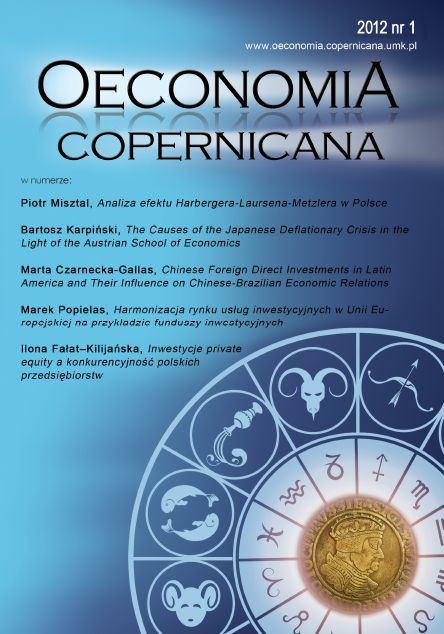The Harber-Laursen-Metzler effect in Poland
DOI:
https://doi.org/10.12775/OeC.2012.001Keywords:
terms of trade, current account, economic growthAbstract
The aim of the paper is to analyse of the Harberger-Laursen-Metzler effect in light of the theory and in practice, with particular reference to this effect in Poland in the period 1995-2009. The results of research carried out by means of the vector autoregression model (VAR) revealed that temporary improvement in terms of trade in Poland led to the current account improvement, and permanent improvement in terms of trade contributed to the current account deterioration. Thus it was confirmed prevalence of the Harberger-Laursen-Metzler effect in Poland. Additionally, results of investigation confirmed relatively greater impact of temporary changes in terms of trade on the current account than in the case of permanent changes in terms of trade. Analogous interdependence was revealed witch reference to explanation of the current account variability. Temporary changes in terms of trade accounted for in much more degree the current account variability in relation to permanent changes in terms of trade.
Downloads
References
Agénor, P.R. (2004), Economics of Adjustment & Growth, Harvard University Press, Harvard.
Bahmani-Oskooe, M. (1998), Cointegration Approach to Estimate the Lung-Run Trade Elasticities in LDCs?, ?International Economic Journal?, No. 12(3).
Chowdhury A.R. (2003), Do asymmetric terms of trade shocks affect private savings in a transition economy?, ?BOFIT Discussion Papers?, No. 3.
Dornbusch R. (1983), Real Interest Rates, Home Goods, and Optimal External Borrowing, ?Journal of Political Economy?, Vol. 91.
Duncan R. (2003), The Harberger-Laursen-Metzler Effect Revisited: An Indirect-Utility-Function Approach, ?Central Bank of Chile Working Papers?, No. 250.
Edwards,S. (1989),Temporary Terms of Trade Disturbances, the Real Exchange Rate and the Current Account, ?Economica?, No. 56.
Eicher T.S., Schubert S.F., Turnovsky S.J. (2008), Dynamic Effects of Terms of Trade Shocks:The Impact on Debt and Growth, ?Journal of International Money and Finance?, Vol. 27.
Harberger A.C. (1950), Currency depreciation, income, and the balance of trade, ?Journal of Political Economy?, No. 58.
International Financial Statistics (2010), International Monetary Fund, Washington.
Kent Ch., Cashin P. (2003), The Response of the Current Account to Terms of Trade Shocks: Persistence Matters, ?IMF Working Paper?, No. 143.
Laursen S., Metzler L.A. (1950), Flexible exchange rates and the theory of employment, ?Review of Economic and Statistics?, No. 32.
Maddala G. S. (2008), Ekonometria, PWN, Warszawa.
Obstfeld M. (1982), Aggregate Spending and the Terms of Trade: Is There a Laursen-Metzler Effect?, ?Quarterly Journal of Economics?, No. 97.
Ostry J., Reinhart C. (1992), Private Saving and Terms of Trade Shocks, ?IMF Staff Papers?, No. 39(3).
Otto, G. (2003), The Effect of Terms of Trade Shocks on the Trade Balance: Is There a Harberger-Laursen-Metzler Effect?, ?Journal of International Money and Finance?, Vol. 22, No. 2.
Persson T., Svensson L. (1985), Current Account Dynamics and the Terms of Trade: Harberger-Laursen-Metzler Two Generations Later, ?Journal of Political Economy?, No. 93(1).
Sachs J. (1981), The Current Account and Macroeconomic Adjustment in the 1970?s, ?Brooking Papers on Economic Activity?, No. 1.
Sen P., Turnovsky S.J. (1989), Deterioration of the Terms of Trade and Capital Accumulation: A Re-examination of the Laursen-Metzler Effect, ?Journal of International Economics?, No. 26.
Servén L. (1995), Capital Goods Imports, the Real Exchange Rate and the Current Account, ?Journal of International Economics?, No. 39.
Tornell A., Lane P. (1994), Are Windfalls a Curse? A Non-representative Agent Model of the Current Account and Fiscal Policy, ?NBER Working Paper?, No. 4839.
Turnovsky S.J. (1997), International Macroeconomic Dynamics, MIT Press, Cambridge.
Wang P. (2009), The Economics of Foreign Exchange and Global Finance, Springer, Berlin.






